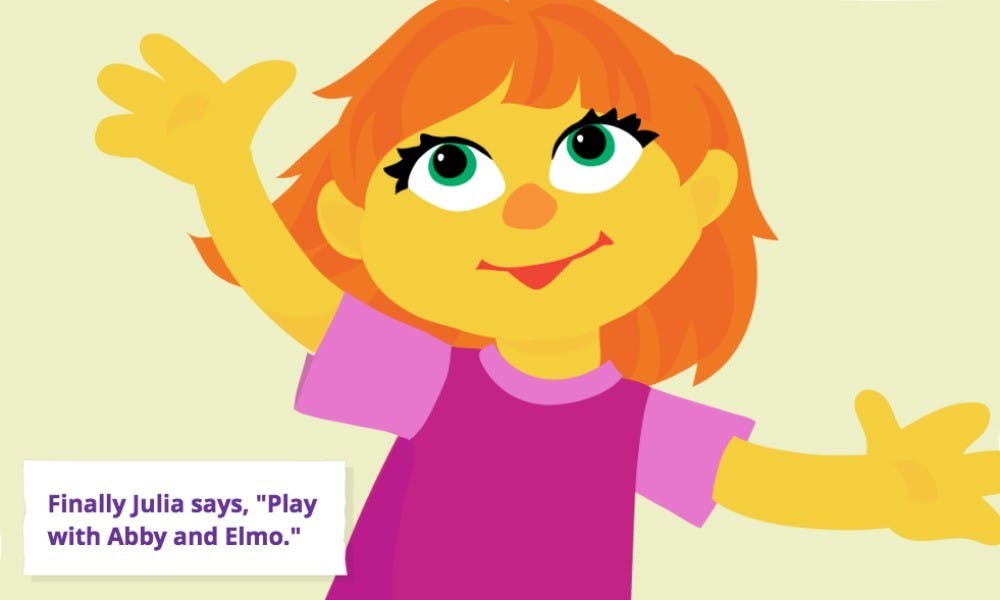I never thought I would say this in such a public way, but here it goes — I have an autism spectrum disorder.
I’m not usually very open about it, because most people don’t even know what that means, let alone understand what people who have autism actually go through. Fortunately, “Sesame Street” is trying to change that. And the show does a great job at it.
This past Wednesday, an autistic character named Julia made her “Sesame Street” debut in an online picture book called “We’re Amazing 1, 2, 3.” When I first found out about this, I wasn’t entirely thrilled. My knee-jerk reaction was that it was probably some kind of empty politically correct gesture by Sesame Workshop to add diversity for diversity’s sake.
Whether you have a child with autism, know someone, or simply want to learn more, check out https://t.co/DxSa7WX9lW. pic.twitter.com/LO4IiSzjF8
— Sesame Street (@sesamestreet) October 21, 2015
Then I read the book and realized the show completely nailed it. The plot summarized the experience of being a young autistic child so perfectly that I felt like I was reading scenes from my own life.
For full disclosure, I have what used to be known as Asperger’s Syndrome, so I can’t identify with all of the language difficulties exhibited by Julia, but everything else was spot-on for me.
There is, however, one major difference between the book and real life, and I think that difference is the book’s biggest strength. Every character Julia interacts with knows how to make simple accommodations for her, making her life a little bit easier without a whole lot of effort. The only exception is Abby, who is slightly put-off by Julia at first, but later learns that Julia is friendly and comes to accept her.
When I say this almost-unrealistic universal acceptance of Julia is the best feature of the book, I mean that the example set by the characters for how people should interact with autistic children has the potential to drastically improve the lives of real children, should their parents, teachers and friends choose to follow it.
Elmo loves his friends Julia and Abby! Elmo enjoys playing with them very much! Hi Julia and Abby! Elmo loves you! pic.twitter.com/38WNYiwXuN
— Elmo (@elmo) October 22, 2015
The book (which I strongly encourage everyone read) contains so many great examples of effective ways to cooperate with children who have autism. My favorite is when Elmo and Abby order hot cocoa at Hooper’s store, and Alan recognizes that Julia is worried because she’s sensitive to hot temperatures, so he gives her chocolate milk instead.
It’s critical for people in the lives of autistic children to be educated about their needs because, especially at such a young age, kids with autism aren’t really aware that they’re so different. Speaking from my own experiences, I used to quietly deal with things that caused me immense distress simply because I didn’t know that the hardships I was enduring weren't typical.
When I was Julia’s age, I thought hiding in your room and covering your ears as tightly as possible was just what you were supposed to do when your mom vacuums the house.
I thought it was acceptable to be mocked almost hourly by your teacher for not being able to control the volume of your voice.
I thought being screamed at by your dad was an appropriate way to be corrected for not knowing how to greet someone in a timely manner.
I thought when your teacher accused you of lying because you’re not looking her in the eyes, it meant you were actually lying and you just didn’t know it.
I thought not being able to drink hot chocolate with the rest of your classmates at Christmastime was a sign of weakness.
Will there always be unavoidable struggles that people with autism spectrum disorders will have to deal with? Of course. Are there always going to be people who don’t accept us for who we are? Of course. But we don’t need practice dealing with adversity from people who can just as easily help us.
The overarching theme of the book is that Julia wants and feels all the same things as Elmo and Abby, just in a slightly different way. The thing that makes the book stand out is the fact that Julia is different, but the message is that Julia and her friends are really all the same.
If "Sesame Street" can get the families and teachers of children with autism to understand that commonly overlooked truth, they can make a tremendous impact on millions of lives.
Related Links:
ASU students learn about autism during Well Devils Week
Innovative nonprofit organization Sounds of Autism touches ASU community
Reach the columnist at cmfitzpa@asu.edu or follow @CodyFitzStories on Twitter.
Editor’s note: The opinions presented in this column are the author’s and do not imply any endorsement from The State Press or its editors.
Want to join the conversation? Send an email to opiniondesk.statepress@gmail.com. Keep letters under 300 words and be sure to include your university affiliation. Anonymity will not be granted.
Like The State Press on Facebook and follow @statepress on Twitter.




